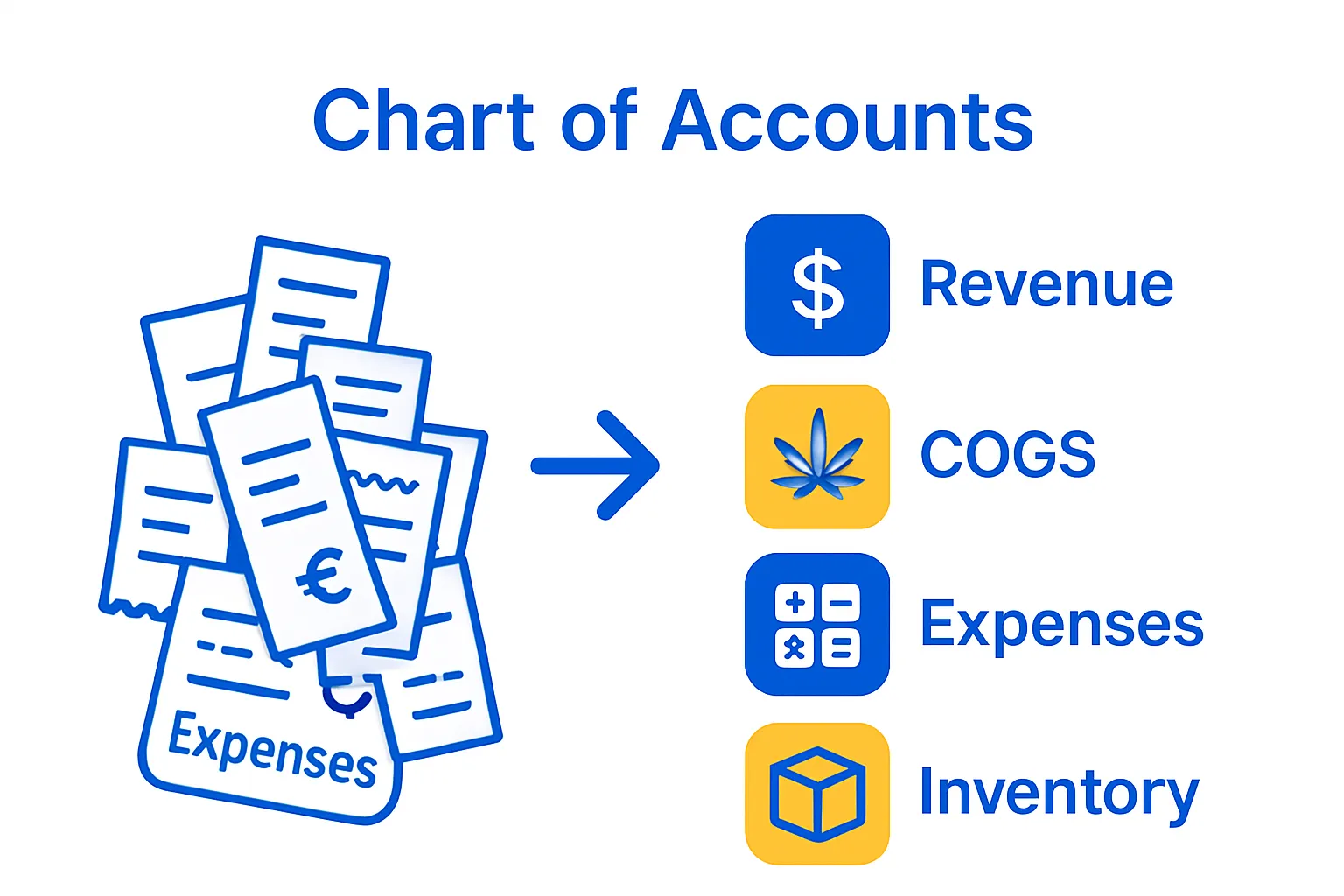Every cannabis business faces a tangled mess of rules and razor-thin margins. One missed compliance detail can trigger fines that swallow up to 40 percent of profits. Surprising as it sounds, the most powerful tool for avoiding disaster is not a fancy legal team or expensive software. It is a sharply structured chart of accounts that quietly makes or breaks cannabis businesses behind the scenes.
Quick Summary
| Takeaway | Explanation |
|---|---|
| Establish a detailed chart of accounts | It helps cannabis businesses categorize every financial transaction clearly and efficiently. |
| Ensure regulatory compliance with financial records | A structured system safeguards against legal risks by maintaining meticulous documentation of financial activities. |
| Leverage financial data for strategic decisions | Utilizing insights from the chart allows businesses to optimize resources and identify growth opportunities. |
| Facilitate accurate tax reporting | A comprehensive chart simplifies tax preparation by providing organized and compliant financial records. |
| Enhance financial transparency and accountability | Clear financial communication aids in accurate reporting and reduces the risk of errors during audits. |
Defining the Chart of Accounts in Cannabis Industry
A chart of accounts represents a systematic financial organization method specifically designed to categorize and track financial transactions within a business. In the cannabis industry, this becomes an essential tool for maintaining clear financial records and ensuring regulatory compliance.
Understanding the Fundamental Structure
A cannabis industry chart of accounts functions as a comprehensive financial mapping system that allows businesses to classify and track every financial transaction with precision. Unlike traditional business accounting, cannabis companies face unique challenges due to complex regulatory environments and specific tax implications.
The core components of a chart of accounts for cannabis businesses typically include several critical categories
Below is a breakdown of key chart of accounts categories specific to the cannabis industry and their primary purposes.
| Chart of Accounts Category | Purpose/Description |
|---|---|
| Revenue Streams | Tracks income from different cannabis product types |
| Cost of Goods Sold (COGS) | Records direct costs associated with producing goods |
| Operating Expenses | Captures day-to-day business costs |
| Compliance & Licensing Costs | Tracks spending on regulatory and licensing requirements |
| Inventory Management Tracking | Monitors product quantities and valuation in real time |
| Tax & Regulatory Reporting | Organizes data needed for accurate tax and legal reporting |
| Audit Trail Documentation | Ensures each transaction leaves a clear, verifiable record |
 :
:
- Revenue streams from different product types
- Cost of goods sold (COGS)
- Operating expenses
- Compliance and licensing costs
- Inventory management tracking
Strategic Financial Classification
Understanding how to classify financial transactions requires deep knowledge of both accounting principles and cannabis industry specifics. According to cannabis financial compliance research, the Internal Revenue Service mandates strict reporting requirements that make a well-structured chart of accounts not just beneficial, but essential.
For cannabis businesses, a robust chart of accounts serves multiple strategic purposes. It helps organizations:
- Maintain transparent financial records
- Simplify tax preparation
- Support accurate financial reporting
- Enable detailed performance analysis
By implementing a comprehensive chart of accounts, cannabis businesses can transform complex financial data into actionable insights.
To clarify the advantages of a robust chart of accounts for cannabis businesses, the table below summarizes major benefits and the impact of each on business operations.
| Benefit | Impact on Cannabis Business Operations |
|---|---|
| Transparent Financial Records | Supports clear documentation and easier regulatory review |
| Simplified Tax Preparation | Speeds up compliance with tax regulations and reduces preparation effort |
| Accurate Financial Reporting | Promotes reliable analysis and audit readiness |
| Detailed Performance Analysis | Enables identification of strengths and weaknesses in the business |
| Enhanced Strategic Decision Making | Informs proactive, data-driven management and investment choices |
| Compliance Risk Reduction | Helps avoid costly penalties and legal complications |
The key is developing a system that balances regulatory compliance with operational flexibility, ensuring your financial documentation meets both legal standards and business intelligence needs.
The Importance of a Structured Financial System
In the cannabis industry, a structured financial system represents more than just record keeping. It serves as a critical shield protecting businesses from potential regulatory risks and financial complications.
Regulatory Compliance and Risk Management
Cannabis businesses operate within an exceptionally complex legal landscape that demands meticulous financial documentation. A structured financial system provides a robust mechanism for tracking every transaction, ensuring transparency and accountability. Research from the National Institute of Health highlights that precise financial tracking is essential for maintaining legal compliance in highly regulated industries.
The key components of an effective financial system include:
- Detailed transaction logging
- Comprehensive expense categorization
- Clear audit trail documentation
- Real-time financial reporting capabilities
- Systematic inventory tracking
Financial Intelligence and Strategic Decision Making
Beyond compliance, a structured financial system transforms raw financial data into strategic intelligence. Cannabis businesses can leverage detailed financial records to:
- Identify profit margin opportunities
- Analyze product performance
- Optimize operational expenses
- Forecast future financial scenarios
- Demonstrate fiscal responsibility to potential investors
Building a sophisticated financial infrastructure requires understanding both technical accounting principles and industry-specific nuances. Precision in financial documentation becomes a competitive advantage, enabling businesses to navigate complex regulatory environments while maintaining financial clarity.
Ultimately, a structured financial system is not an optional enhancement but a fundamental requirement for sustainable cannabis business operations. It provides the foundation for strategic growth, regulatory compliance, and long-term financial success.
How Chart of Accounts Enhances Financial Reporting
Financial reporting in the cannabis industry demands precision, transparency, and strategic documentation. A well-designed chart of accounts serves as the foundational framework that transforms raw financial data into meaningful, actionable business intelligence.
Standardizing Financial Communication
A comprehensive chart of accounts creates a standardized language for financial communication across an organization. By establishing clear, consistent categories for financial transactions, businesses can generate reports that provide immediate insights into financial performance. According to research from the Internal Revenue Service, standardized financial documentation is crucial for maintaining regulatory compliance and accurate tax reporting.
Key benefits of a structured chart of accounts include:
- Simplified financial analysis
- Enhanced comparability of financial data
- Reduced risk of reporting errors
- Improved decision-making capabilities
- Streamlined audit processes
Generating Advanced Financial Insights
Beyond basic record keeping, an advanced chart of accounts enables cannabis businesses to conduct sophisticated financial analysis. It allows organizations to:
- Track revenue by product category
- Monitor operational efficiency
- Identify potential cost-saving opportunities
- Assess profitability across different business segments
- Prepare comprehensive financial statements
By understanding IRC 471, businesses can further refine their financial reporting strategies, ensuring they maximize tax compliance while maintaining detailed financial transparency.
The chart of accounts is more than a technical accounting tool. It represents a strategic asset that empowers cannabis businesses to transform complex financial data into clear, actionable insights that drive sustainable growth and operational excellence.
Navigating Compliance and Regulatory Requirements
Compliance in the cannabis industry represents a complex landscape of federal, state, and local regulations that demand meticulous financial documentation and strategic planning. A robust chart of accounts serves as the primary mechanism for maintaining transparency and meeting intricate regulatory standards.
Understanding Federal and State Regulatory Frameworks
Cannabis businesses operate under unprecedented regulatory scrutiny that requires comprehensive financial tracking and reporting. Research from the Internal Revenue Service highlights the critical importance of maintaining detailed financial records that demonstrate precise cost allocation and transaction documentation.
Key regulatory compliance considerations include:
- Strict documentation of all financial transactions
- Detailed inventory tracking
- Comprehensive expense categorization
- Transparent revenue reporting
- Precise tax calculation and reporting
Strategic Compliance Management
Effective regulatory navigation requires more than basic record keeping. Cannabis businesses must develop sophisticated financial systems that anticipate and address potential compliance challenges. By implementing a detailed chart of accounts, organizations can:
- Demonstrate financial transparency
- Minimize audit risks
- Ensure accurate tax reporting
- Maintain detailed transaction histories
- Support potential future licensing requirements
For businesses seeking deeper insights into regional regulatory nuances, exploring state-specific cannabis regulations can provide additional strategic guidance.
Ultimately, a well-structured chart of accounts transcends basic financial management. It becomes a critical compliance tool that protects businesses from potential legal and financial complications while establishing a foundation for sustainable, transparent operations.
Utilizing Chart of Accounts for Business Growth
A strategic chart of accounts transcends traditional financial record keeping, emerging as a powerful tool for driving business growth and making informed strategic decisions in the cannabis industry. By transforming raw financial data into actionable insights, businesses can unlock significant competitive advantages.
Financial Performance Analysis
A well-designed chart of accounts enables cannabis businesses to conduct deep financial performance analysis. According to financial management research, systematic financial categorization allows organizations to identify precise revenue streams, cost centers, and potential investment opportunities.
Key strategic analysis capabilities include:
- Tracking profitability by product line
- Identifying high-margin revenue segments
- Monitoring operational cost efficiency
- Comparing performance across different business units
- Detecting potential investment areas
Strategic Resource Allocation
Beyond performance tracking, a comprehensive chart of accounts provides critical insights for strategic resource allocation. By breaking down financial data into granular categories, businesses can:

- Optimize inventory management
- Prioritize high-performing product categories
- Reallocate resources from underperforming segments
- Make data-driven expansion decisions
- Forecast future financial scenarios
Dispensary accounting strategies demonstrate how precise financial tracking can transform operational decision making.
Ultimately, a strategic chart of accounts is not merely an accounting requirement but a dynamic business intelligence tool. It empowers cannabis businesses to navigate complex market landscapes, make informed decisions, and create sustainable pathways for long-term growth and success.
Take Control of Your Cannabis Financial Systems Today
Are you struggling with confusing transaction categories, compliance risks, or unclear cost tracking in your cannabis business? The article highlighted how a well-structured chart of accounts can solve these problems by improving transparency, easing tax preparation, and helping you avoid costly compliance issues. If regulatory headaches, Section 280E, and rapid industry changes feel overwhelming, you’re not alone. Clear financial organization is the key to staying ahead.
Visit our Cannabis Accounting page to discover specialized resources, guides, and actionable strategies that will help you set up or improve your chart of accounts. For targeted tax guidance, explore the Cannabis Tax category. Take the next step now by joining industry leaders who trust Cannabis Business Minds to ensure their accounting practices are compliant and future-proof.
Frequently Asked Questions
What is a chart of accounts in the cannabis industry?
A chart of accounts in the cannabis industry is a systematic method for categorizing and tracking financial transactions. It helps cannabis businesses maintain clear records and ensures compliance with regulatory requirements.
Why is a structured financial system important for cannabis businesses?
A structured financial system is crucial for cannabis businesses as it provides a robust mechanism for tracking financial transactions, ensuring transparency and accountability, and protecting against regulatory risks.
How does a chart of accounts enhance financial reporting in cannabis businesses?
A well-designed chart of accounts standardizes financial communication, simplifies financial analysis, and generates meaningful insights, making it easier for cannabis businesses to report financial performance accurately and comply with regulations.
What are the benefits of implementing a chart of accounts for cannabis companies?
Implementing a chart of accounts allows cannabis companies to maintain transparent financial records, simplify tax preparation, support accurate financial reporting, and conduct detailed performance analyses to identify growth opportunities.
